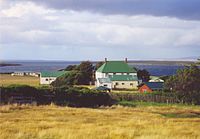Bunch grass

Bunch grass is a type of plant that grows in the wild. Imagine that you are in a big field and you see patches of grass that are growing close together in clumps or 'bunches' rather than all spread out. These are called bunch grasses. They look a bit different from regular grass because they grow in clumps and often have taller stems with seeds at the top.
Bunch grass can also be found in lots of different places, like prairies, savannas, mountain meadows, and even deserts. When you see fields in the countryside covered in tall grass with brown, fluffy tops, that could very well be bunch grass.
One of the reasons why bunch grass is important is because it helps keep soil healthy. When bunch grass dies, it leaves a lot of organic matter behind that is great for growing other plants. Bunch grass also helps prevent erosion by anchoring the soil with its strong root system. Its roots reach deep into the ground and hold onto the soil even when there are strong winds or heavy rainfall.
Not only is bunch grass important for the environment, but it also helps feed and shelter a lot of animals. Birds eat the seeds from the tops of the stems, and small mammals like mice and rabbits love to hide in the clumps of grass to avoid predators.
So, in summary, bunch grass is a type of plant that grows in clumps and helps keep soil healthy, prevent erosion, and provide food and shelter for many different animals.
Bunch grass can also be found in lots of different places, like prairies, savannas, mountain meadows, and even deserts. When you see fields in the countryside covered in tall grass with brown, fluffy tops, that could very well be bunch grass.
One of the reasons why bunch grass is important is because it helps keep soil healthy. When bunch grass dies, it leaves a lot of organic matter behind that is great for growing other plants. Bunch grass also helps prevent erosion by anchoring the soil with its strong root system. Its roots reach deep into the ground and hold onto the soil even when there are strong winds or heavy rainfall.
Not only is bunch grass important for the environment, but it also helps feed and shelter a lot of animals. Birds eat the seeds from the tops of the stems, and small mammals like mice and rabbits love to hide in the clumps of grass to avoid predators.
So, in summary, bunch grass is a type of plant that grows in clumps and helps keep soil healthy, prevent erosion, and provide food and shelter for many different animals.
Related topics others have asked about:
